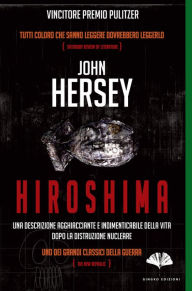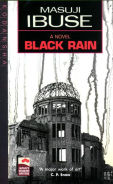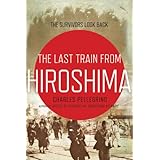This is our last look back at books concerning the atomic bombings of Japan from our vantage point 70 years later.
We discuss here two books by Charles Pellegrino. But the two books are really one.
The first titled: THE LAST TRAIN FROM HIROSHIMA:The Survivors Look Back, published - then "pulped" by Henry Holt in 2010.
The second titled: TO HELL AND BACK:The Last Train From Hiroshima, published this month by Rowan & Littlefield.
In a previous Post, July 6, we mentioned the controversy that greeted the publication of Pellegrino's 2010 book which led to the pulping and recall of that book by Holt.
We are not discussing here the political factors involved in that decision and the controversy that led to it. But we can briefly compare and contrast parts of the two versions/editions of Pellegrino's book.
The new book TO HELL AND BACK features new reporting and new testimony from atomic bomb survivors who stepped forward to be heard as a result of the public attacks on the 2010 book.
This time the author has provided us with extensive, academic-style footnotes - 352 Footnotes in all. This is in contrast to the 2010 edition which featured only an essay style "Notes" section of a few pages.
The chapter titles remain the same.
The new book contains a "Preface" and a "Foreword."
The new edition contains extensive black and white line drawings - the 2010 edition only had a few of these illustrations.
The new edition eliminates some inaccuracies as well as a questionable source witness that Pellegrino relied on in the first book.
For a brief but thorough summary (which also defends the author) read the "Foreword" by Steven Leeper.
For example, Pellegrino admits that he was deceived by one "witness". This became "the Fuoco furor" as it was termed at the time of the erupting controversy. But a perusal of the new edition, along with the old, shows that the approximately five pages of Joseph Fuoco's "story" (he claimed, falsely, to have been a flight engineer aboard the Hiroshima photo plane) have been eliminated.
Another example is the person of "Father Mattias" who Pellegrino later acknowledged to be a composite of several Catholic priests. In the new edition he places the name "Mattias" in quotation marks, and in the "Acknowledgments" section states that the priest's name was "changed by request and by contractual agreements going back as far as 1986." This kind of ambiguity only confuses the issue.
In HISTORY AS STORY we compare and contrast non-fiction history books with fiction books concerning the same subject, events, place and time. It appears that the author here had used the novelistic device of merging several characters into one.
An issue that received much attention in 2010 was/is the author's connection to renowned movie director James Cameron (Titanic, Terminator, Avatar). Cameron claims Charles Pellegrino as a friend and Pellegrino has worked with the director on several of his films.
Cameron defended his friend from attacks leveled on him over the 2010 book. In fact, now the director appears in an added section of TO HELL AND BACK in a scene depicting his emotional visit with Mr. Yagamuchi, who was a double hibakusha - that is a survivor of both Hiroshima and Nagasaki- at his hospital bedside in December 2009.
The phrase "last train from Hiroshima" in the book titles refers to the final train that left atomic-bombed Hiroshima and headed to Nagasaki where those people on the train found themselves beneath a second atomic bomb three days later, August 9, 1945.
"I had no choice but to come here and meet you." Cameron told Yagamuchi. The director has told of being haunted by childhood fears of growing up with a fear of nuclear holocaust. See Terminator 2 and its harrowing, criticized by some, nuclear apocalypse "playground scene."
"I believe you experienced both atomic bombs for a reason, making you a link in the chain of human memory." Noting that the hibakusha survivors are now very aged - Yagamuchi 93 at the time of Cameron's visit - the director continued "It's the rest of the world that has to try and remember for them. So now it is up to us to do something about it, and to everyone of good conscience to do something about it."
Yet, despite his purchase of the film rights to the book in 2010 and a promise to Yagamuchi to make a film about the August Atomic bombings, it remains unclear whether the film will ever be made. (See "Foreword)
The new edition contains an emotionally wrenching story of one of the "lost boys" orphaned by the bombings. As a teenager one of them is ostensibly offered employment in the U.S. as part of an American effort to assist these orphans. In heartbreaking reality, the boy is, in effect, "kidnapped" to be used as "a guinea pig."
"I was an experiment in the hands of doctors acting in the name of radiation research." With no family to help him, he was confined to a California mental hospital where he describes the "treatment" as "torture" including bone marrow sampling and spinal taps which continued for weeks until his "case" was heard by a judge who had him released to a nurse who had intervened on his behalf against the doctors in charge of the program. The boy called her his "guardian angel" and she, Mary Furr, in fact, became his legal guardian. He credits her with saving his life and changing it for the better. "Her caring began to thaw a heart frozen by hatred and revenge."
The boy grew into the adult Mr. Thomas Tanemori and in another new section of the book he has a bitter, somewhat shocking encounter with Enola Gay pilot Paul Tibbets.
Some 56 years after the atomic bombings, in 2001, Tibbets was traveling the country giving "lectures" about his atomic bomb mission. One lecture was given near the site of the Trinity Test in New Mexico not far from history's first nuclear explosion.
During his speech Tibbets had peppered his remarks by referring to the Japanese as "Japs" and by using derogatory expletives to describe them. The now elderly Mr. Tanemori approached the podium and attempted to question General Tibbets (then himself in his mid eighties).
"With all the facts we have now - would you obey the order, or would you refuse?"
"With all the facts we have now - would you obey the order, or would you refuse?"
In reply Tibbets "yelled, shaking a finger in Tanemori's face and uttering something horrible, before pushing Tanemori forcefully to one side and commanding his entourage, "Let's go!'
Tanemori's response as Tibbets walked out: "General Tibbets, I pray for you, until you find peace in your heart!"
The recommendation here is to read Pellegrino's new edition - TO HELL AND BACK. It is a needed addition to the powerful pantheon of books on this still troubling and important subject.
Read On.


 Hiroshima(with "target bridge")
Hiroshima(with "target bridge")




